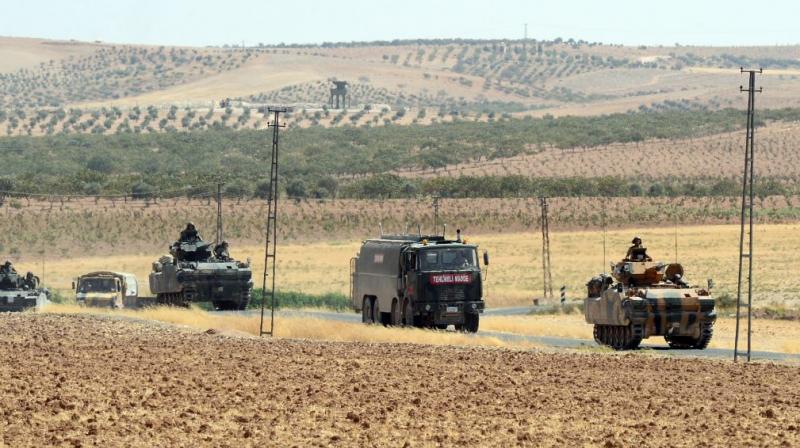Syria's key border crossings with Jordan, Israel to be reopened
16 October, 2018

Jordan and Syria have agreed to reopen a vital border crossing between the two countries, three years after the commercial lifeline fell to rebel groups and traffic was halted.
Israel also said on Sunday that the Quneitra crossing with Syria will reopen on Monday to United Nations observers, four years after it was closed because of the fighting.
The reopening of the crossings is a major boost to the Syrian government, keen on sending messages to its citizens and the world that it is slowly emerging victorious from the bloody conflict and beginning to restore vital services and relations.
In eastern Syria, state TV said its broadcast has returned to Deir el-Zour city, seven years after it was halted when armed groups seized control of the area.
Reopening the crossing with Jordan would bring major relief to President Bashar Assad’s government by restoring a much-needed gateway for Syrian exports to Arab countries. It is also expected to boost its coffers as the government is expected to collect transit fees from convoys coming from Jordan. Last month, it hiked fees for all trailers transiting through its territories.
The resumption of commercial trade through the crossing will also be a diplomatic victory for Assad, whose government has been isolated from its Arab neighbors since the war began in 2011.
Arab countries have boycotted the Syrian government since the early days of the war, freezing its membership in the 22-member state Arab League.
Jordan government spokeswoman Jumana Ghunaimat said the Naseeb crossing would be opened Monday after operational details have been agreed upon, according to the Jordanian Petra news agency. Syria’s Interior Minister Mohammed al-Shaar also confirmed the crossing’s reopening, according to Syria’s state news agency.
“The Naseeb crossing is a vital lifeline for trade between the two brotherly countries Jordan and Syria through them to other Arab countries,” Ghunaimat said, according to Petra. Rebels seized the crossing in 2015, disrupting a major trade route between Syria and Jordan, Lebanon and oil-rich Gulf countries.
The two governments had earlier issued conflicting reports of when the crossing would open.
Syrian troops recaptured it in July this year after rebels reached an agreement with Russian mediators to end the violence in the southern province of Daraa and surrender the crossing.
The crossing is also vital for Syria’s neighboring Lebanon, providing its agricultural products a route to foreign markets.
The recapture of Naseeb crossing marked a major victory for Assad’s forces, which have been on a winning streak since 2015 when Russia threw its military weight behind Damascus. The victory in southern Syria signaled the return of his forces to Daraa province where the uprising against him began seven years ago.
Fighting has subsided across most of Syria, but in the absence of a political deal, more than 40 percent of the country’s territory remains in the hands of armed opposition and their foreign supporters
On Sunday, Israel’s military announced that the United Nations has decided to return its peacekeeping force, known as UNDOF, to the Quneitra crossing area. The crossing will be used exclusively for UN forces, it added.
The Syrian government plans to escort media to the crossing Monday.
Syrian forces recaptured the Quneitra area in July. Russian military police deployed in the area, including on the edge of the Israeli-occupied Golan Heights, setting up checkpoints in the area. Moscow said it planned to work closely with the UN force.
Israel captured the Golan Heights in the 1967 war. The UNDOF deployed in the area in 1974.
Separately, Syrian state said Sunday technicians have installed two transmitters to restore the broadcast of the terrestrial TV station and Voice of Youth radio to the eastern city of Deir el-Zour and surrounding areas for the first time in seven years. It was the latest in government efforts to restore normal life to areas it has recaptured from armed groups.
Government forces, aided by Russian air craft and allied militia, chased IS fighters out of the city and most of the western banks of the Euphrates river last year.
In a separate offensive that occasionally raised tensions, rival US-backed Syrian Defense Forces fought the militants on the eastern banks of the river and along the border with Iraq. The Kurdish-led forces, backed by US-led coalition air power, continue to battle IS militants in Hajin, a small pocket east of the river.
On Saturday, IS militants stormed a settlement for displaced people in Hajin and abducted scores of civilians. The Britain-based Syrian Observatory for Human Rights said 130 families were kidnapped.
The US-led coalition said it couldn’t confirm news of the kidnapping. It said it has been dropping leaflets requesting that civilians leave the area for months “to avoid the brutal tactics” of the extremist group.
IS “has used innocent civilians as human shields in the past and leaflets often give them instructions for the quickest and safest exits, but we fully understand many have no other places to go,” said Col. Sean Ryan, spokesman for the US-led coalition.
Omar Abou Leila, a Deir el-Zour native residing in Europe who runs the Deir el-Zour 24 news network, said the militants also abducted SDF fighters.
Images appeared on social media of the militants holding at least a couple of men wearing uniforms. In the posting, the militants boasted it has taken Kurdish fighters captive. Ryan, of the coalition, said he could not confirm whether SDF fighters were taken. Deir el-Zour, Syria’s oil-rich province, has been scene to fighting between government forces and insurgents since the start of the war in 2011. The militants seized control of most of it in 2014. But IS has lost most of its self-declared caliphate in Syria and Iraq over the last two years.
